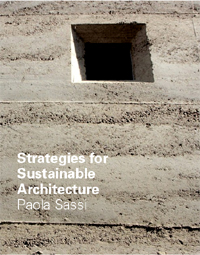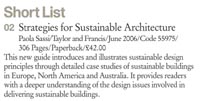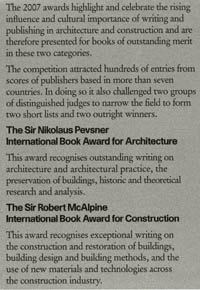![]() Publications
Publications
Sassi,
P. - Strategies for Sustainable Architecture
Taylor Francis, 2006
Strategies for Sustainable Architecture was shortlisted for the RIBA International Book Award 2007 and came second.
The Back Cover Description
Strategies for Sustainable Architecture introduces the principal aspects
of sustainability and their relation to the built environment. Environmental
and social issues are analysed and sustainable design and technical solutions
are discussed through the use of case studies in the UK, USA, Australia,
Germany, Austria and Switzerland.
There are six chapters covering the topics of land and ecology, community,
health and well-being, materials, energy, and water. Each chapter includes
an overview of the current environmental or social problems and explores
ways that buildings and urban developments can be developed to mitigate
the impacts of these problems. The author discusses different approaches
and uses completed examples to illustrate how theoretical principles work
in practice. Nearly one hundred case studies of sixty buildings and urban
developments demonstrate the strategies adopted by designers, clients
and planners to address sustainability.
This book should be of great interest to all those learning about sustainability
as well as building industry clients and professionals involved in setting
targets and developing design solutions.
Strategies for Sustainable Architecture is currently being translated into Italian.



Strategies
for Sustainable Architecture - CONTENT
Chapter 1 - INTRODUCTION
Chapter 2 - THE SITE AND ECOLOGY
2.1 Compact cities
2.2 Reducing transport impacts
2.3 In harmony with nature
2.4 Local food production
Chapter 3 - COMMUNITY AND CULTURE
3.1 Community participation
3.2 Housing for all
3.3 Training and employment
3.4 Spaces for the community
3.5 Promoting sustainability
Chapter 4 - HEALTH AND WELL-BEING
4.1 Comfort
4.2 Insensible Agents of disease
4.3 Independence and identity
4.4 Restorative environments
Chapter 5 - MATERIALS
5.1 Design For Longevity
5.2 Waste As A Resource
5.3 Avoiding resources depletion
5.4 Minimising manufacturing impacts
5.5 Materials and Energy
5.6 Waste Minimisation
Chapter 6 - ENERGY
6.1 Minimising energy needs
6.2 Maximising efficiently
6.3 'Green' energy sources
Chapter 7 - WATER
7.1 Minimising need and maximising efficiency
7.3 Alternative water sources
7.3 Reducing the use of mains drains
8 Postscript
Appendix 1 - Projects overview
Appendix 2 - Location maps
Appendix 3 - Climate
References and Bibliography
Index